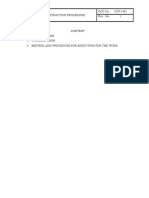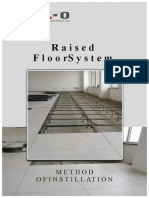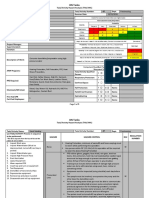SECTION 02221 Trench Excavating and Backfilling: Part 1 General
SECTION 02221 Trench Excavating and Backfilling: Part 1 General
Uploaded by
JojolasCopyright:
Available Formats
SECTION 02221 Trench Excavating and Backfilling: Part 1 General
SECTION 02221 Trench Excavating and Backfilling: Part 1 General
Uploaded by
JojolasOriginal Title
Copyright
Available Formats
Share this document
Did you find this document useful?
Is this content inappropriate?
Copyright:
Available Formats
SECTION 02221 Trench Excavating and Backfilling: Part 1 General
SECTION 02221 Trench Excavating and Backfilling: Part 1 General
Uploaded by
JojolasCopyright:
Available Formats
SECTION 02221
TRENCH EXCAVATING AND BACKFILLING
PART 1 GENERAL
1.1 DESCRIPTION
A. This section covers trench excavating, backfilling, grading and compacting required for the
installation of pipelines, appurtenances and connections.
1.2 RELATED WORK
A. Related work specified in other sections:
1. Section 01563 - Control of Water
2. Section 02210 - Site Grading
3. Section 02222 - Excavation and Backfill for Structures
1.3 SHOP DRAWINGS
A. Certification shall be submitted for each class of backfill stating that it conforms to the Contract
Documents.
PART 2 PRODUCTS
2.1 BACKFILL
A. Backfill is considered to be material placed in excavation. Backfill material shall be clean, free of
wood waste, roots, brush, sticks, debris, junk, broken concrete, brick, pavement, lumps of clay and
frozen material. Material passing the No. 200 sieve shall be non-plastic. The backfill material
shall meet the requirements for the aggregate base contained in Section 02222.2.01.A.
PART 3 EXECUTION
A. Shoring or Bracing of Excavations
1. The banks of trenches, where required to control trench width and protect adjacent structures,
shall be sheeted and braced at no additional expense to the OWNER. Where shoring, sheeting,
bracing or steel strutted trench boxes are necessary, they shall be furnished, placed, maintained
and, except as shown or specified otherwise, removed. Where damage is liable to result from
the removal of the sheeting, then the sheeting will be required to be left in place and cut off if
required or directed.
2. The design, planning, installation and removal, if required, of steel strutted trench boxes or
sheeting, shoring, lagging, and bracing shall be accomplished in such a manner as to maintain
the required excavation or trench section and to maintain the undisturbed state of the soils
below and adjacent to the excavation.
3. The use of horizontal strutting below the barrel of the pipe or the use of the pipe as support for
trench bracing will not be permitted. Sheet piling and timbers in trench excavations shall be
withdrawn in a manner so as to prevent subsequent settlement of the pipe or additional backfill
loadings which might overload the pipe.
4. Following removal of shoring, bracing or steel strutted trench boxes, the space left due to such
removal shall be backfilled immediately and the backfill compacted.
02221-1 Trench Excavating and Backfilling
SECTION 02221
TRENCH EXCAVATING AND BACKFILLING
B. Trench Excavation
1. General
a. Excavation of every description and of whatever substance encountered shall be
performed, to the depths, lines and grades indicated or specified. It may be necessary to
increase or decrease the quantity of excavation because of unknown factors. The
ENGINEER reserves the right to change the trench alignment from that indicated by 10
feet horizontally without additional expense to the OWNER. If additional piping is
required, this will be at the expense of the OWNER.
2. Trenches
a. Unless otherwise indicated, excavation shall be open cut. During excavation, material
suitable for backfilling shall be stockpiled in an orderly manner, a distance back from the
edges of the excavations specified by the governing safety agency. Materials unsuitable
for backfilling shall be wasted as specified. Caution shall be exercised in operating heavy
equipment over pipelines. Leaks or breaks caused by the CONTRACTOR’S operations
shall immediately be repaired at no additional expense to the OWNER and in a manner
acceptable to the ENGINEER. The banks of excavated areas shall be controlled as is
necessary to prevent movement of soil in areas supporting existing foundations, slabs, pole
lines, underground power or telephone cables, trees, pipelines or other structures. If, as a
result of the excavation or through fault or neglect of the CONTRACTOR, the earth or
ground under or around such foundations, slabs, pole lines, underground power or
telephone cables, trees, pipelines or other structures, slips or is otherwise disturbed,
corrective measures shall be taken as directed at no additional expense to the OWNER.
b. In the event the maximum allowable trench width is exceeded, the CONTRACTOR may
be required, depending on the depth of trench, to improve the pipe bedding by utilizing
concrete or other bedding materials as necessary to assure that the type of pipe installed
can withstand the loads imposed by the backfill due to the depth of the trench.
c. The bottom of the trench shall be excavated to the lines and grades shown with proper
allowance for pipe thickness, and for foundation stabilization and special bedding when
required. Material containing rocks or cobbles larger than 2 inches in maximum dimension
shall not be permitted within 6 inches of the pipe. Material of this type shall be removed
from the bottom of the trench and replaced with backfill material. Parts of the trench
excavated below grade shall be corrected with backfill as specified. The depth of trenches
shall be as indicated.
C. Backfilling
1. General
a. The area shall be finished off to uniform contour to properly drain, and the entire surface
graded to result in a neat appearing surface. In the event of natural cross drainage, a
depressed section shall be formed through the crowned backfill.
b. Immediately after backfilling, excess dirt shall be removed from the area. In addition,
damage to existing roadways, ditches, culverts, driveways, and other existing
improvements, shall be repaired at this time.
2. Foundation Preparation
a. Where clay, peat or other soft material is encountered that may be saturated with water but
does not break down into fine particles and flow such as does silt or sand, a foundation
material shall be used to stabilize the soft material in the bottom of the trench. This
02221-2 Trench Excavating and Backfilling
SECTION 02221
TRENCH EXCAVATING AND BACKFILLING
foundation material shall be backfill placed to a minimum depth of 12 inches below the
bottom of the pipe bell.
b. Proper preparation of foundation, placement of granular foundation material where
required and placement of bedding material shall precede the installation of pipe and
appurtenances. This shall include the necessary leveling of trench bottom, the removal of
loosened material, rocks and cobbles larger than 2 inches in maximum dimension and
leveling of foundation stabilization material and bedding material to a uniform grade to
provide uniform bearing and support for each length of pipe on undisturbed or compacted
material at every point, along its entire length, except at joints. Bell holes shall be
excavated to an extent sufficient to permit accurate work in making and inspecting of the
joints.
3. Pipe Bedding
a. Bedding of the pipe shall be done only in the presence of the ENGINEER, after foundation
preparation, laying of and jointing of the pipe.
b. As the pipe is installed it shall be bedded by hand with material as shown. Care shall be
taken to prevent any damage or shifting of the pipe. The pipe bedding material shall be
compacted into place to the same density as specified for backfill above the pipe bedding.
Backfilling shall continue above the pipe bedding material with materials as specified.
c. Pipe bedding shall extend a minimum of 6 inches over the top of the pipe or to the depth
shown. Rocks and cobbles exceeding 2 inches in maximum dimension shall be removed to
a minimum depth of 6 inches below the bottom of the pipe.
D. Compaction
1. Compaction under roadways and driveways shall be by towed or self propelled mechanical
compactors in uniform layers not exceeding 8 inches in loose depth. Each layer shall have the
proper moisture content during compaction. Compaction shall be to 95% minimum relative
compaction as determined by ASTM D 1557, Method D.
2. Compaction in other areas shall be by towed or self propelled mechanical compactors in
uniform layers not exceeding 8 inches in loose depth. Compaction shall be to 90% minimum
relative compaction as determined by ASTM D 1557, Method D.
3. Compaction within 3 feet of existing or new structures shall be by hand operated vibratory
compactors.
4. Trenches where settlement occurs shall be reopened to the depths necessary for compaction,
then refilled and compacted, with the surface restored to grade.
5. Water settling or water jetting will not be allowed as a method of obtaining compaction.
E. Cleanup
1. Surplus and unsuitable excavated materials, abandoned pipe, broken pavement, and rubbish,
shall be removed from the construction site in a timely manner. Surplus and unsuitable
excavated materials shall be loaded directly to waste; no stockpiling will be permitted.
Disposal of waste materials shall conform to all laws, regulations and ordinances and be
disposed of at a site obtained by the CONTRACTOR.
2. Side ditches which have been affected by the CONTRACTOR’S operations shall be cleared,
drained through points so affected, and if the area affected is extensive the entire drain ditch
shall be reformed.
02221-3 Trench Excavating and Backfilling
SECTION 02221
TRENCH EXCAVATING AND BACKFILLING
3. Following placing of pipe, backfilling and testing, roadways, roadway shoulders and unpaved
streets shall be finished to a uniform cross section. Areas adjacent to the trench that are
disturbed as the result of construction under this Contract shall be restored to their original
condition.
- END OF SECTION -
02221-4 Trench Excavating and Backfilling
You might also like
- 18 - Confined Space THA-AHADocument7 pages18 - Confined Space THA-AHAJojolas50% (2)
- Method Statement For Raft FootingDocument5 pagesMethod Statement For Raft FootingLokesh Saran100% (1)
- Example Method StatementDocument9 pagesExample Method StatementMuhammadWazimAkramNo ratings yet
- Example Method Statement For The Installation of Roof TrussesDocument8 pagesExample Method Statement For The Installation of Roof TrussesSai Shankar LakshminarayananNo ratings yet
- How To Calculate Anchorage and Lap Lengths To Eurocode 2Document9 pagesHow To Calculate Anchorage and Lap Lengths To Eurocode 2selinaNo ratings yet
- Method of Statement For Blinding WorkDocument6 pagesMethod of Statement For Blinding WorkMohd Muksin100% (1)
- 9 - Aerial Lifts and Scissor Lifts THA-AHADocument5 pages9 - Aerial Lifts and Scissor Lifts THA-AHAJojolas100% (2)
- Method Statement Trial TrenchDocument6 pagesMethod Statement Trial TrenchSasi KumarNo ratings yet
- Example Method Statement For The Installation of Concrete Floor SlabsDocument8 pagesExample Method Statement For The Installation of Concrete Floor SlabsMohammad Ali ElhamNo ratings yet
- Sewer Line MosDocument6 pagesSewer Line MosToyEn MEgat100% (1)
- Method Statement FOR Concreting Work: ProjectDocument6 pagesMethod Statement FOR Concreting Work: ProjectKelvin LauNo ratings yet
- Method Statement HoldingDocument3 pagesMethod Statement Holdingqoci5koNo ratings yet
- MOS Wood Doors InstallationDocument2 pagesMOS Wood Doors InstallationRenoMasr100% (1)
- Method Statements For Earth Work ExcavationDocument5 pagesMethod Statements For Earth Work ExcavationKrm Chari100% (1)
- Construction Box CulvertDocument4 pagesConstruction Box CulvertKhalid OsmanNo ratings yet
- Civil Construction ProcedureDocument6 pagesCivil Construction Procedureคุณพ่อน้อง บิ๊กบอสNo ratings yet
- Complete Method Statement Infrastructure Development at DHADocument14 pagesComplete Method Statement Infrastructure Development at DHAJahanzeb Khan100% (1)
- Air Distribution For Large Spaces PDFDocument7 pagesAir Distribution For Large Spaces PDFJojolasNo ratings yet
- Rieber Sealing in AmericaDocument10 pagesRieber Sealing in Americaulloap*100% (1)
- SECTION 700 (Pipe Drains, Pipe Culvert, Concrete Channels)Document9 pagesSECTION 700 (Pipe Drains, Pipe Culvert, Concrete Channels)akvosmNo ratings yet
- RC Retaining Wall: Method Statement For Concreting Vertical Elements Setting OutDocument3 pagesRC Retaining Wall: Method Statement For Concreting Vertical Elements Setting OutAnonymous ze9ag1No ratings yet
- MOS-002B Door Frame, Door Leaf & IronmongeriesDocument6 pagesMOS-002B Door Frame, Door Leaf & IronmongeriesChezy629No ratings yet
- De-Watering Method StatementDocument1 pageDe-Watering Method StatementSupun SandaruwanNo ratings yet
- Paving Method StatementDocument7 pagesPaving Method StatementOfentse LedwabaNo ratings yet
- Method Statement For Electrical Conduit and Box Fixing WorksDocument7 pagesMethod Statement For Electrical Conduit and Box Fixing Worksprashant100% (1)
- WMS - Pipe Laying OutsideDocument4 pagesWMS - Pipe Laying OutsideLasandu WanniarachchiNo ratings yet
- MOS (Installation of Ceramic Tile) REV2Document3 pagesMOS (Installation of Ceramic Tile) REV2Don Roseller DumayaNo ratings yet
- Method Statement of Concreting Pile Cap Rev01Document2 pagesMethod Statement of Concreting Pile Cap Rev01Mohd Hafizul Hj TanalolNo ratings yet
- Work Method Statement FOR Reinforced Concrete WorksDocument5 pagesWork Method Statement FOR Reinforced Concrete WorksLynn Mail100% (2)
- 2.method Statement Excavation and TrenchingDocument4 pages2.method Statement Excavation and Trenchingشاز إياس100% (1)
- Method Statement For Cement Wall PlasteringDocument10 pagesMethod Statement For Cement Wall Plasteringmd_rehan_2No ratings yet
- Site OrganizationDocument40 pagesSite OrganizationDejene TsegayeNo ratings yet
- Method Statement HoldingDocument4 pagesMethod Statement Holdingqoci5koNo ratings yet
- Method Statement For Concrete WorkDocument6 pagesMethod Statement For Concrete WorktotA ahmedNo ratings yet
- Detailed Specification For Earth Work ExcavationDocument24 pagesDetailed Specification For Earth Work ExcavationMadumitha RameshNo ratings yet
- Method Statement FOR Acoustic Ceiling TilesDocument12 pagesMethod Statement FOR Acoustic Ceiling Tilesraks07010% (1)
- MOS of Installation Rise FloorDocument13 pagesMOS of Installation Rise FloorHussam WaleedNo ratings yet
- Water RecDocument9 pagesWater RecToyEn MEgatNo ratings yet
- Method Statement for Formwork, Reinforcement bars and Ready Mix Concrete عامDocument20 pagesMethod Statement for Formwork, Reinforcement bars and Ready Mix Concrete عامM.ZEKEBA50% (2)
- Earthworks Method Statement - 1Document5 pagesEarthworks Method Statement - 1Liz LizzyNo ratings yet
- Method Statement SLABDocument11 pagesMethod Statement SLABdeviesrigatiNo ratings yet
- Method Statement For Sign Board InstallationDocument45 pagesMethod Statement For Sign Board InstallationEngr Primus ChinonyeNo ratings yet
- Rev Description Prepared by Approved by Date Method Statement For Cold Water Services PJSBDocument5 pagesRev Description Prepared by Approved by Date Method Statement For Cold Water Services PJSBToyEn MEgatNo ratings yet
- Method Statement For ExcavationDocument7 pagesMethod Statement For Excavationspwong99100% (3)
- Method Statement - Shoring and Excavation For Soakaway Tank - Hub Park RevisedDocument13 pagesMethod Statement - Shoring and Excavation For Soakaway Tank - Hub Park Revisedyaswanth reddy mummadiNo ratings yet
- Method Statement FencDocument5 pagesMethod Statement FencKhairul Adli Mohd RaniNo ratings yet
- Method Statement of AbutmentDocument8 pagesMethod Statement of AbutmentSaeed Ahmed SoomroNo ratings yet
- MTS-Hard Landscaping & Road WorksDocument7 pagesMTS-Hard Landscaping & Road WorksAshimolowo BabatundeNo ratings yet
- Method Statement Drainage WorkDocument13 pagesMethod Statement Drainage WorkShua ChuahNo ratings yet
- Method Statement For Earth WorkDocument5 pagesMethod Statement For Earth Workgvs raoNo ratings yet
- 12 - Method Statement For Steel Structure ErectionDocument5 pages12 - Method Statement For Steel Structure ErectionidzwanNo ratings yet
- 1 - Method StatementDocument29 pages1 - Method StatementsyedtalhamehmoodNo ratings yet
- Method of Statement For Excavation WorksDocument3 pagesMethod of Statement For Excavation Worksaboodeissa97No ratings yet
- Method Statement - BOX CULVERTDocument5 pagesMethod Statement - BOX CULVERTjps.anienurinaNo ratings yet
- Clearing, Grubbing and ExcavationDocument11 pagesClearing, Grubbing and ExcavationArah Louise ApostolNo ratings yet
- MS-001-Form Work, Reinforcement Steel & Concrete WorksDocument12 pagesMS-001-Form Work, Reinforcement Steel & Concrete WorksFrancis Phillip CapistranoNo ratings yet
- Work Method Statement FOR Plastering Works at Information CenterDocument2 pagesWork Method Statement FOR Plastering Works at Information CenterLynn MailNo ratings yet
- Method Statement of Brick Masonary WorkDocument6 pagesMethod Statement of Brick Masonary WorkMihirduttaNo ratings yet
- Method Statement For Leakage Testing of Gravity Sewer LineDocument3 pagesMethod Statement For Leakage Testing of Gravity Sewer LineGerlie DimayugaNo ratings yet
- BrickworkDocument2 pagesBrickworkLynn Mail100% (1)
- Method Statement - Plastering, Dated. Jan. 03. 2007Document5 pagesMethod Statement - Plastering, Dated. Jan. 03. 2007mohamed4879No ratings yet
- Work Method Statement For Block WorkDocument6 pagesWork Method Statement For Block Workronaldo aguirreNo ratings yet
- Pipeline InstallationDocument6 pagesPipeline InstallationSurya Kiran KNo ratings yet
- EARTHWORK SpecificationDocument3 pagesEARTHWORK Specificationczarjeff3497No ratings yet
- Tech Specs Chapter 2Document6 pagesTech Specs Chapter 2ChanelNo ratings yet
- 47 - Hand Blasting THA-AHADocument5 pages47 - Hand Blasting THA-AHAJojolasNo ratings yet
- Constant Velocity Duct DesignDocument5 pagesConstant Velocity Duct DesignJojolasNo ratings yet
- 4 - Powered Industrial Truck THA-AHADocument5 pages4 - Powered Industrial Truck THA-AHAJojolasNo ratings yet
- Look Ahead ScheduleDocument9 pagesLook Ahead ScheduleJojolasNo ratings yet
- Project Management Project PlanDocument6 pagesProject Management Project PlanJojolasNo ratings yet
- 1 - Construction Mobilization THA-AHADocument5 pages1 - Construction Mobilization THA-AHAJojolas0% (1)
- Fire Hydrant BrochureDocument2 pagesFire Hydrant BrochureJojolasNo ratings yet
- 014 Water Reticulation System 2016 - 04 - 01Document10 pages014 Water Reticulation System 2016 - 04 - 01JojolasNo ratings yet
- Project Deployment Plan TemplateDocument42 pagesProject Deployment Plan TemplateJojolasNo ratings yet
- Horizontal End Suction Pumps: Flowmore LimitedDocument36 pagesHorizontal End Suction Pumps: Flowmore LimitedJojolasNo ratings yet
- Temperature Measuring DeviceDocument1 pageTemperature Measuring DeviceJojolasNo ratings yet
- T&C of Pressurization UnitDocument6 pagesT&C of Pressurization UnitMohamed YousufNo ratings yet
- Bput Exams - ResultsDocument2 pagesBput Exams - ResultstapaswinistuNo ratings yet
- Gauri Shankar 1st OfficeDocument62 pagesGauri Shankar 1st Officenirez14No ratings yet
- Cabana StructuralDocument1 pageCabana StructuralAlsean Soriano DetubioNo ratings yet
- Zak Precast Concrete India Invite PDFDocument6 pagesZak Precast Concrete India Invite PDFShashank KumarNo ratings yet
- 10.1016@B978 0 12 812693 6.09991 0Document2 pages10.1016@B978 0 12 812693 6.09991 0ZNo ratings yet
- Design of Lift Wall: Axial LoadDocument3 pagesDesign of Lift Wall: Axial LoadSavithri Murthy50% (2)
- Sample SOP Computer Science Engineering WWW - ApplyDocument2 pagesSample SOP Computer Science Engineering WWW - ApplyMohammadchaman NooriNo ratings yet
- Marathon Oil UK LLC Marathon House, Anderson DR, Aberdeen AB15 6FZ, United KingdomDocument4 pagesMarathon Oil UK LLC Marathon House, Anderson DR, Aberdeen AB15 6FZ, United KingdomAljohn Camunias100% (1)
- Final Quality Management PlanDocument65 pagesFinal Quality Management PlanIrfan100% (1)
- Ultrasonic Testing of Welds Report: Wisconsin Department of Transportation DT2104 2004 (Replaces EM771)Document2 pagesUltrasonic Testing of Welds Report: Wisconsin Department of Transportation DT2104 2004 (Replaces EM771)Abdul GhafoorNo ratings yet
- UWI Timetable Final 201010Document14 pagesUWI Timetable Final 201010807000998No ratings yet
- Beltran Assignment Ce202Document11 pagesBeltran Assignment Ce202Christian Kyle BeltranNo ratings yet
- PROFESSIONAL ETHICS SYLLABUS-Ktunotes - inDocument6 pagesPROFESSIONAL ETHICS SYLLABUS-Ktunotes - inAnto MustangsNo ratings yet
- Ibrahim Tarek cv-1Document3 pagesIbrahim Tarek cv-1Sec. 2B.N. 33Eslam Ahmed Mohamed MostafaNo ratings yet
- O-Ring Cross ReferenceDocument40 pagesO-Ring Cross Referencecamohunter71No ratings yet
- Work 2007-08Document96 pagesWork 2007-08Liu KeeNo ratings yet
- White Paper:: Balconies and Thermal BridgingDocument16 pagesWhite Paper:: Balconies and Thermal BridgingzakarinskeNo ratings yet
- Adaptive Kinetic Architecture - A Portal To Digital Prototyping PDFDocument13 pagesAdaptive Kinetic Architecture - A Portal To Digital Prototyping PDFZull-Kefle IsmailNo ratings yet
- 6006Document8 pages6006Mayur BahiratNo ratings yet
- Entry Level Civil Engineering ResumeDocument4 pagesEntry Level Civil Engineering Resumef634dexc100% (2)
- Presentation Title: Software Development Life CycleDocument35 pagesPresentation Title: Software Development Life CycleRakesh Ranjan KumarNo ratings yet
- Machine Test System BrochureDocument8 pagesMachine Test System BrochureAhmet GumusNo ratings yet
- Iet Diy FC Reg Form v2Document3 pagesIet Diy FC Reg Form v2Antvan JesudassNo ratings yet
- R2 - Design Formulae For Bending (2014!08!01)Document44 pagesR2 - Design Formulae For Bending (2014!08!01)Abhishek KumarNo ratings yet
- Poles Inspection Report Docx PDFDocument2 pagesPoles Inspection Report Docx PDFsaeedNo ratings yet
- On Beam-Column Moment Amplification FactorDocument6 pagesOn Beam-Column Moment Amplification Factorzeek77100% (1)






































































































